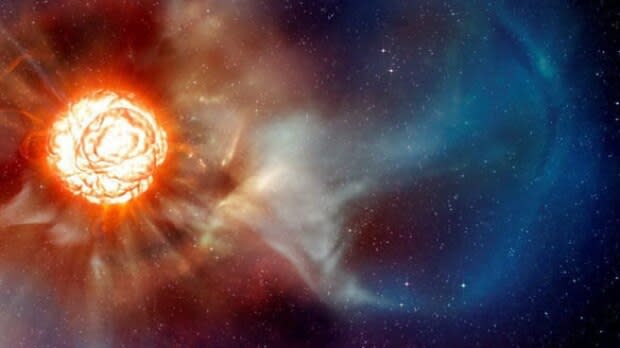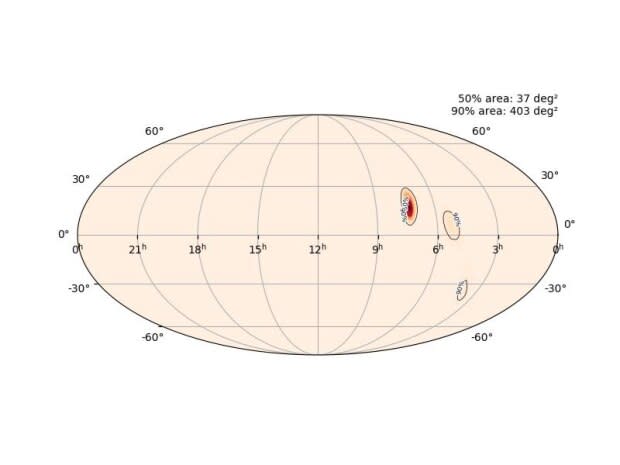Is a gravitational wave detection near Betelgeuse a sign the star is ready to explode?
First it was the strange dimming of Betelgeuse. Now it's a gravitational wave that once again has astronomers scratching their heads over this enigmatic star found in the constellation Orion.
Betelgeuse has been grabbing a few headlines lately, as the normally bright star dimmed to its lowest point ever recorded — and astronomers don't exactly know why.
Now the U.S.-based Laser Interferometer Gravitational-Wave Observatory (LIGO) has detected a gravitational wave coming from that direction, adding another intriguing detail to what's happening.
The first gravitational wave ever recorded — a powerful ripple through space-time caused by cataclysmic events, like two merging black holes — was detected in September 2015.
Since then, many more have been found, including one resulting from the merger of two black holes, as well as one from a binary neutron star merger. (A potential black hole-neutron star detection is still waiting to be confirmed.)

But seeing as Betelgeuse is still there, a source for the newly detected gravitational wave is unknown.
Normally, Betelgeuse is a bright red star found in the left "shoulder" of Orion.
It's classified as a semi-regular variable star, meaning that it dims periodically, but not on a regular basis. (It has two periods when it dims: roughly once every 430 days and once every six years.)
During each cycle, dark spots appear on the surface of Betelgeuse, similar to the sunspots sometimes seen on the sun, but far, far larger.

The type of dimming seen on Betelgeuse now, however, is unprecedented.
Betelgeuse is believed to be roughly 425 to 650 light years away and is huge: likely about 1,400 times larger than our sun and about 14,000 times as luminous. As a result, the star is likely at the end of its life cycle and ready to die.
And it will do so in a spectacular fashion relatively soon: As an explosion known as a supernova.
All of that means this latest activity has some people wondering if — and possibly hoping — that will happen in the coming days.
It's important to note that when it comes to astronomical terms, "relatively soon" can mean sometime within a few hundred thousand years. And when that happens, Betelgeuse will be as bright as the full moon and visible during the day.
So does this new gravitational wave mean the star is ready to go "Boom!" at any moment? Probably not.
For one, the wave detection is coming from the direction of Betelgeuse — but not necessarily from Betelgeuse itself, said Salvo Vitale, a physics professor at MIT who works with LIGO.
As well, just before a supernova, neutrinos are released from a star. That hasn't happened yet. Added to that, he said, is the fact that Betelgeuse is still shining in the night sky, albeit considerably dimmer than normal.
"So putting all those things together, speaking, of course, only on behalf of myself, I would not think that the gravitational-wave candidate … is in any way related to Betelgeuse," said Vitale.

There's also the chance that what was detected isn't even a gravitational wave at all. The detection doesn't have the characteristics of any known mergers, so it's a mystery as to what caused the detection. (Sometimes a wave results from noise coming from Earth itself, though this isn't believed to be the case in this instance).
A false alarm for something like this would only occur once in 25 years.
While that may seem like pretty good odds that it's not a false alarm, Vitale notes that other sources of gravitational waves — such as a neutron star-black hole merger — have false alarms more in the range of one in 1,000 years or one in a million years.
"One in 25 years is good, but it is not exceptional," said Vitale. "There is always, in our business, … this saying that when you are [looking at] odds, a good kind of threshold is: Would you bet your coffee on this? Would you bet your car? Or would you bet your house?
"I am, I think, around maybe between coffee and a meal."
In the meantime, Vitale said, followup observations are continuing.
The future of Betelgeuse
One of the theories for the deep dimming of Betelgeuse is that its two cycles — the 430-day and the six-year ones — have occurred at the same time, causing the deep darkening we're currently observing.
The question is: How much more could the star dim?
"We're talking about uncharted territory here. We have no idea," said Stella Kafka, CEO of the American Association of Variable Star Observers (AAVSO). "It's one of those things that is happening for the first time in its recorded history."
It will take a few years to determine whether the dimming is indeed part of a merging of cycles, Kafka said.
She said she is also excited that, for the first time, it's not the large telescopes and astronomical organizations that are doing the observing: Anyone can see Betelgeuse for themselves, even in light-polluted skies.
In fact, because the star is typically so bright, observations with smaller telescopes are needed, as well as naked-eye observations — something the AAVSO is calling on amateur astronomers to do more of.
And it's the twin mysteries — the deep dimming and the strange gravitational wave — that makes Betelgeuse so interesting, she said.
"The public is very intrigued and very interested in a star that we take for granted," Kafka said. "How many stars do 'interesting' things?
"This is new science in the making," she added. "It's actually part of our everyday experience, and we don't get to do that very often."

